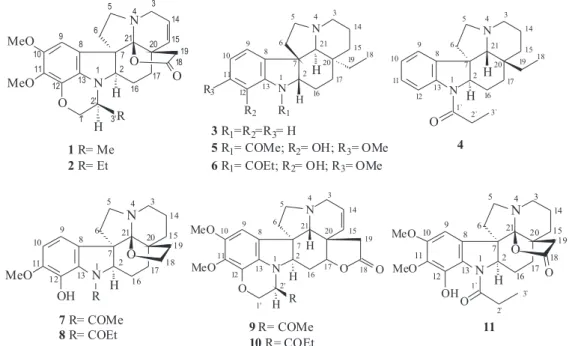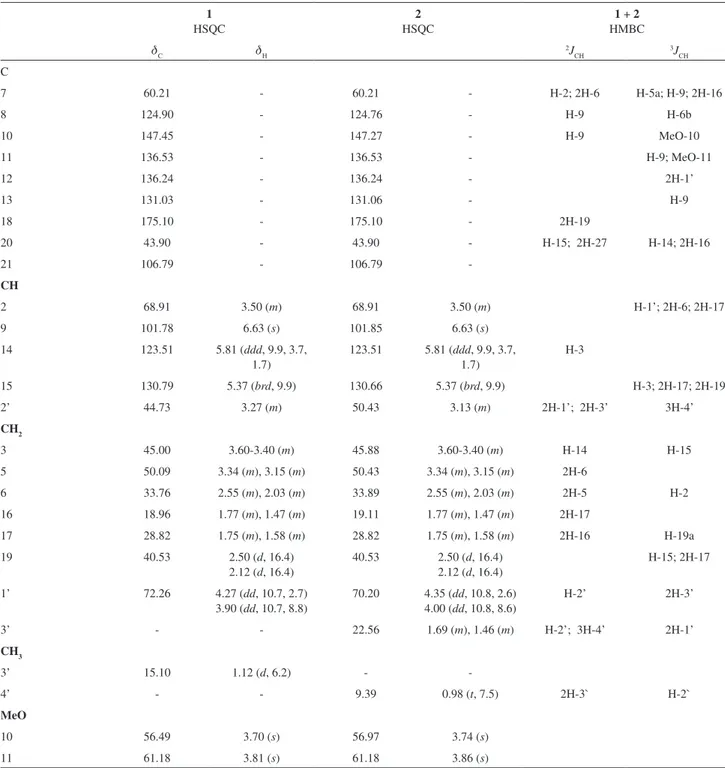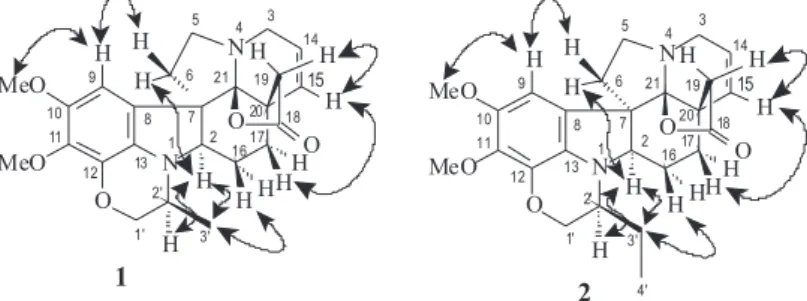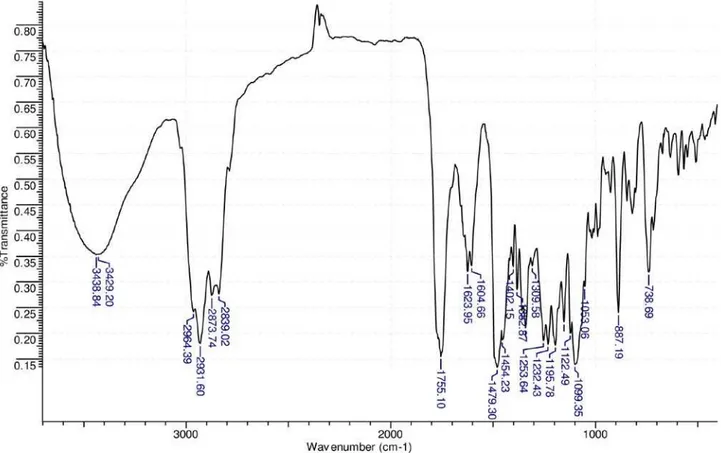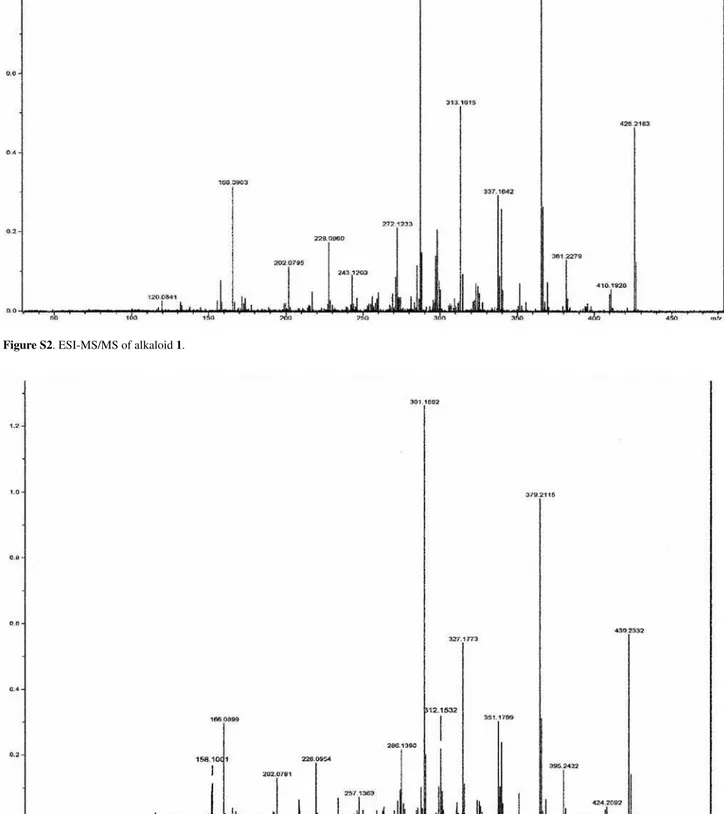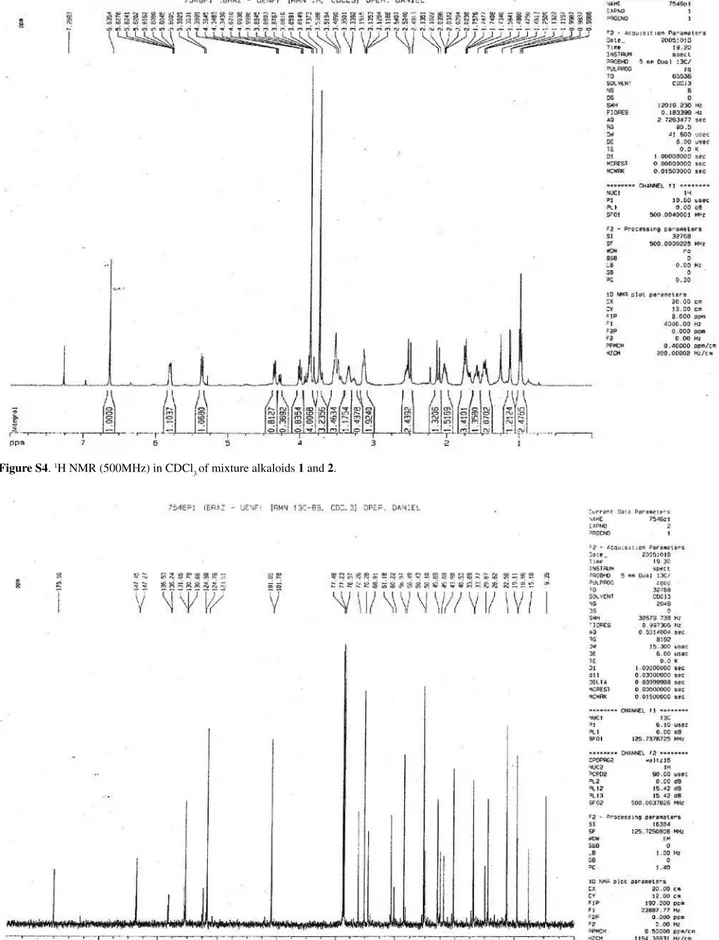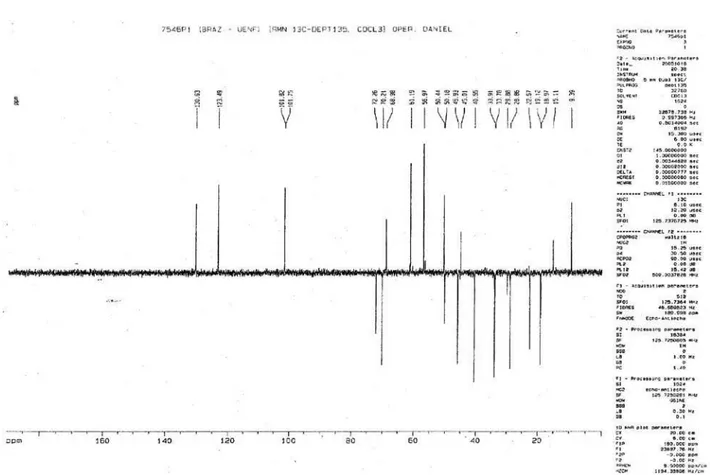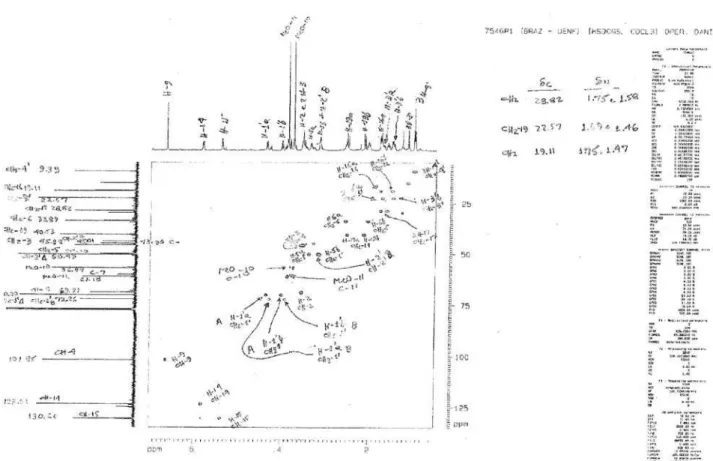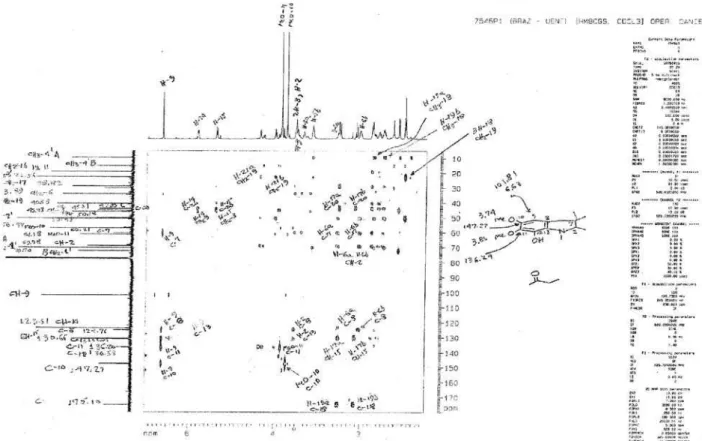Article
0103 - 5053 $6.00+0.00*e-mail: braz@uenf.br
Spruceanumines A and B, Novel Plumeran Indole Alkaloids from Aspidosperma spruceanum
(Apocynaceae)
Vilma B. Oliveira,a Ivo J. Curcino Vieira,a R. Braz-Filho,*,b Leda Mathias,a
Norberto P. Lopes,c Antonio E. M. Crottid and Daniel E. de A. Uchôa e
aLaboratório de Ciências Químicas (LCQUI)-CCT, Universidade Estadual do Norte Fluminense Darcy Ribeiro (UENF),
28013-602 Campos dos Goytacazes-RJ, Brazil
bPesquisador Visitante Emérito-FAPERJ, Laboratório de Ciências
Químicas(LCQUI)-CCT-UENF/PPGQO-DEQUIM-UFRRJ, 28013-602 Campos dos Goytacazes-RJ, Brazil
cFaculdade de Ciências Farmacêuticas de Ribeirão Preto-USP, 14040-903 Ribeirão Preto-SP, Brazil
dNúcleo de Pesquisas em Ciências Exatas e Tecnológicas, Universidade de Franca,14404-600 Franca-SP, Brazil
eCentro Nordestino de Aplicação e Uso da Ressonância Magnética Nuclear, Departamento de Química Orgânica e
Inorgânica, Universidade Federal do Ceará, 60021-97 Fortaleza-CE, Brazil
Dois novos alcalóides indólicos com esqueleto plumerano, spruceanuminas A (1) e B (2), e oito alcalóides indólicos conhecidos, aspidospermidina (3), desmetoxipalosina (4), aspidocarpina (5), aspidolimina (6), fendlerina (7), aspidolimidina (8), obscurinervidina (9) e obscurinervina (10), foram isolados do extrato metanólico das cascas do caule e sementes de Aspidosperma spruceanum. As estruturas dos compostos foram elucidadas com base na análise de dados espectroscópicos, principalmente os obtidos por espectros de RMN 1H e 13C (1D e 2D) e por espectrometria de massas.
Two novel indole alkaloids with plumeran skeleton, spruceanumines A (1) and B (2), and eight known indole alkaloids, aspidospermidine (3), demethoxypalosine (4), aspidocarpine (5), aspidolimine (6), fendlerine (7), aspidolimidine (8), obscurinervidine (9) and obscurinervine (10) were isolated from stem bark and seeds methanolic extracts of Aspidosperma spruceanum. Compounds structures were elucidated on the basis of spectroscopic data, mainly those obtained by 1H and 13C NMR (1D and 2D) and mass spectrometry.
Keywords:Aspidosperma spruceanum, Apocynaceae, plumeran indole alkaloids
Introduction
The Aspidosperma (Apocynaceae) genus is endemic to Americas and is found mainly in regions between Mexico and Argentina.1 Aspidosperma genus continues to be
fascinating as an expressive source of indole alkaloids with novel skeletons, which are interesting from a biosynthetic perspective and reported biological properties. Several species of Aspidosperma are broadly used in popular medicine as potential antimalarial agents, leishmaniose treatment, uterus and ovary inflammation, as contraceptive, in diabetes, in stomach problems, against cancer, fever and rheumatism.2
Aspidosperma spruceanum (A. spruceanum ), commonly known as “Paratudo-Branco” in Atlantic forest in the North of Espírito Santo State, appears as a tree of 5-20 m. The isolation and structure elucidation of two alkaloids from stem bark of A. spruceanum collected in Rio de Janeiro State, Brazil, were reported.3
In the present paper, we describe the isolation and characterization of two novel plumeran indole alkaloids named as spruceanumines A (1) and B (2), along with known indole alkaloids: aspidospermidine (3),4-7 demethoxypalosine (4),7-9 aspidocarpine (5),8,10,14
aspidolimine (6),8,14 fendlerine (7),15,16 aspidolimidine
(8),8,13,15 obscurinervidine (9)14,17 and obscurinervine
(10).14,17 Their structures were established by spectrometric
Spruceanumines A and B, Novel Plumeran Indole Alkaloids from Aspidosperma spruceanum J. Braz. Chem. Soc. 754
magnetic resonance (NMR), as well as high resolution electron spray ionization mass spectra (HRESIMS).
Results and Discussion
Elaboration of stem bark and seeds methanol extract of A. spruceanum by classical chromatographic methods resulted in the isolation of ten plumeran indole alkaloids (1-10), whose structures are shown in Figure 1. The well-known plumeran indole alkaloids, aspidospermidine (3), demethoxypalosine (4), aspidocarpine (5), aspidolimine (6), fendlerine (7), aspidolimidine (8), obscurinervidine (9) and obscurinervine (10) were identified on the basis of
1H and 13C NMR spectral data, including 1H-1H correlation
spectroscopy (COSY), 1H-1H nuclear overhauser effect
spectroscopy (NOESY), heteronuclear single quantum coherence (HSQC) and heteronuclear multiple bond correlation (HMBC) NMR experiments,18 which were also
used to complete unambiguous 1H and 13C chemical shift
assignments of 1 and 2.
Spruceanumines A (1) and B (2), were obtained as a mixture of amorphous form, [a]D23 = -101.7 (CHCl
3, c 0.61).
Infrared (IR) spectrum showed bands at νmax 3100-2890 (C-H stretching), νmax 1755 (stretching of theγ-lactone carbonyl group) in addition to other bands at νmax 1624, 1606 and 1497 (C=C stretching of the benzene ring), and 887 and 739 cm-1
(C-H bending of substituted benzene ring).19
Comparative analysis of the {1H}- and distortionless
enhancement by polarization transfer (DEPT) 135°- 13C
NMR spectra (Table 1) revealed signals corresponding to
24 (1) or 25 (2) carbon atoms, allowing to recognize the presence of signals corresponding to nine nonhydrogenated [(C)9: three sp3 (including one bounded to nitrogen and
oxygen atoms at dC 106.79), six sp
2 (including one carbonyl
group at dC 175.10 and five sp
2 attributed to aromatic ring],
five methine [(CH)5: two sp3 linked to nitrogen atom (d C
68.91/dH 3.50 and dC 44.73/dH 3.27 correlated in the HSQC
spectrum with 1H chemical shifts at d
H 3.50 and 3.27,
respectively, as indicated also in the direct subsequent correlations, 1J
CH) and three sp
2 (one aromatic at d
C 101.78/ dH 6.63 (s) and two olefinic at dC 123.31/dH 5.81 (ddd) and
130.79/dH 5.37 (brd)], seven (1) and eight (2) sp
3 methylene
[(CH2)7 or (CH2)8, including one linked to oxygen atom at
dC 72.26 (1) and 70.20 (2, revealing γ-effect of the methyl
group CH3-4’)] and three methyl [(CH3): dC 15.10/dH 1.12
(d, J = 6.2 Hz), 1; dC 9.39/dH 0.98 (t, J = 7.5 Hz), 2; and
(MeO)2 represented by signals at dC 56.49/dH 3.70 (s) and
61.18/dH 3.81 (s), 1; dC 56.97/dH 3.74 (s) and 61.18/dH
3.86 (s), 2] carbon atoms, allowing to deduce the expanded molecular formulae (C)7(C=O)(N-C-O)(CH)5(O-CH2) (CH2)6(CH3)(MeO)2 and (C)7(C=O)(N-C-O)(CH)5(O-CH2) (CH2)7(CH3)(MeO)2 for 1 and 2, respectively. This later contains additional metylene group CH2 (dC 22.56/dH 1.69
(m) and 1.46 (m) coupled to the hydrogens of an adjacent methyl group (dC 9.39/dH 0.98 (t, J= 7.5 Hz).
The high resolution electro-spray ionization mass spectrum (ESI-MS) of 1 and 2 showed peaks corresponding to the protonated molecules [M+H]+ at m/z 425.2170 of 1
(C24H29N2O5 = m/z 425.2076, ∆m/z 0.0094) and 439.2332 of
2 (C25H31N2O5 = m/z 439.2233, ∆m/z 0.0099) Daltons, which
together with the NMR 13C spectrum enable to propose
molecular formulas C24H28N2O5 (1) and C25H30N2O5 (2), respectively, containing twelve degrees of unsaturation (C24H52N2O5 - C24H28 N2O5 = H24 or C25H54N2O5 -C25H30N2O5 = H24), which is consistent with the structure of alkaloids containing the nucleus of 21-oxo-aspidoalbidine20 (11,
aspidospermidin-18,21-olide, using actual numeration) as basic structure (eleven degrees of unsaturation = four corresponding to aromatic ring, two to carbonyl lactone group and additional pentacyclic moiety), which after the location of one 1,2-disubstituted double bond between the carbon atoms CH-14 and CH-15 and of one heterocyclic
Table 1. 1H (500 MHz) and 13C (125 MHz) NMR data of mixture spruceanumines A (1) and B (2), in CDCl
3 as solvent and TMS used as internal reference.
Chemical shifts (d, ppm) and coupling constants (J, Hz, in parenthesis)*
1
HSQC
2
HSQC
1 + 2
HMBC
dC dH
2J CH
3J CH
C
7 60.21 - 60.21 - H-2; 2H-6 H-5a; H-9; 2H-16
8 124.90 - 124.76 - H-9 H-6b
10 147.45 - 147.27 - H-9 MeO-10
11 136.53 - 136.53 - H-9; MeO-11
12 136.24 - 136.24 - 2H-1’
13 131.03 - 131.06 - H-9
18 175.10 - 175.10 - 2H-19
20 43.90 - 43.90 - H-15; 2H-27 H-14; 2H-16
21 106.79 - 106.79
-CH
2 68.91 3.50 (m) 68.91 3.50 (m) H-1’; 2H-6; 2H-17
9 101.78 6.63 (s) 101.85 6.63 (s)
14 123.51 5.81 (ddd, 9.9, 3.7, 1.7)
123.51 5.81 (ddd, 9.9, 3.7, 1.7)
H-3
15 130.79 5.37 (brd, 9.9) 130.66 5.37 (brd, 9.9) H-3; 2H-17; 2H-19
2’ 44.73 3.27 (m) 50.43 3.13 (m) 2H-1’; 2H-3’ 3H-4’
CH2
3 45.00 3.60-3.40 (m) 45.88 3.60-3.40 (m) H-14 H-15
5 50.09 3.34 (m), 3.15 (m) 50.43 3.34 (m), 3.15 (m) 2H-6
6 33.76 2.55 (m), 2.03 (m) 33.89 2.55 (m), 2.03 (m) 2H-5 H-2
16 18.96 1.77 (m), 1.47 (m) 19.11 1.77 (m), 1.47 (m) 2H-17
17 28.82 1.75 (m), 1.58 (m) 28.82 1.75 (m), 1.58 (m) 2H-16 H-19a
19 40.53 2.50 (d, 16.4)
2.12 (d, 16.4)
40.53 2.50 (d, 16.4) 2.12 (d, 16.4)
H-15; 2H-17
1’ 72.26 4.27 (dd, 10.7, 2.7)
3.90 (dd, 10.7, 8.8)
70.20 4.35 (dd, 10.8, 2.6) 4.00 (dd, 10.8, 8.6)
H-2’ 2H-3’
3’ - - 22.56 1.69 (m), 1.46 (m) H-2’; 3H-4’ 2H-1’
CH3
3’ 15.10 1.12 (d, 6.2) -
-4’ - - 9.39 0.98 (t, 7.5) 2H-3` H-2`
MeO
10 56.49 3.70 (s) 56.97 3.74 (s)
11 61.18 3.81 (s) 61.18 3.86 (s)
*Number of hydrogens bound to carbon atoms deduced by comparative analysis of {1H}- and DEPT-13C NMR spectra. Chemical shifts and coupling
Spruceanumines A and B, Novel Plumeran Indole Alkaloids from Aspidosperma spruceanum J. Braz. Chem. Soc. 756
involving the N-substituent and the oxygen atom sustained by carbon atom C-12, justifying the presence of OCH2 (1: dC 72.26/dH 4.27 and 3.90; 2: dC 70.20/dH 4.35 and
4.00, revealing shielding induced by γ-effect of the methyl 3H-4’), methyl group represented by a doublet signal (J = 6.2 Hz) at dH 1.12 (3H-3’ correlated in the HSQC
spectrum with 13C chemical shift at d
C 15.10) coupled
hydrogen linked to nitrogenated carbon atom (dH 3.27
, m, H-2’ correlated with 13C signal at d
C 44.73, CH-2’)
in the alkaloid 1 and by a triplet signal (J = 7.5 Hz) at
dH 0.98 (3H-4’) coupled to hydrogen atoms of the additional
methylene of 2 (dH 1.69 and 1.46 correlated in the HSQC
with 13C chemical shift at d
C 22.56). The lower field 13C
chemical shift CH-2’ (dC 50.43) in compound 2 when to
that of 1 (dC 44.73) is indicative of a β-effect induced by
the methyl group CH3-4’, as shown in Table 1.
The identity of the six-membered heterocyclic ring containing and oxygen, was supported by 3J
CH HMBC
correlations between C-12 [(dC 136.24, 1 and 2)] and
2H-1’ [dH 4.27 and 3.90 (1); dH 4.35 and 4.00 (2) (Table
1), as well as by 1H-1H-COSY cross-peaks displayed by
H-1`b (dH 4.27 in 1; 4.35 in 2), H-1`a (dH 3.90 in 1; 4.00
in 2), H-2` (dH 3.27 in 1; 3.13 in 2).
The 1H-1H-COSY spectrum (Table 1) showed coupling
of methylenic hydrogens at dH 4.27 [(dd, J = 10.7 and 2.7
Hz, H-1’b (1)] and dH 3.90 [(dd, J = 10.7 and 8.8 Hz, H-1’a
(1)] with the methinic hydrogen at dH 3.27 (m, H-2’, 1)
and atdH 4.35 [(dd, J = 10.8 and 2.6 Hz, H-1’b (2)] and dH 4.00 [(dd, J = 10.8 and 8.6 Hz, H-1’a (2)] correlated
with the signal at dH 3.13 [(m, H-2’, 2)], in agreement with
the presence six-membered ring formation.
The assignment of a methyl group at C-2’ was confirmed by its 1H-1H-COSY and 3J
CH HMBC correlations with H-2’
(dH 3.27) and 2H-1’ (dH 4.35 and 4.00), respectively.
In spruceanumine B (2), the presence of an ethyl group at C-2 was confirmed by the coupling of the methylenic hydrogens CH2-3’ (dH 1.69 and 1.46) with the vicinal
methyl group (dH 0.98) and H-2’ (dH 3.13).
The 1H NMR spectrum of mixture showed signals at dH 3.70 (1), 3.74 (2) and dH 3.81 (1), 3.86 (2), which are
characteristics of methoxyl groups linked to the benzene
ring.19 These signals showed heteronuclear interaction
via one bond (1J
CH) with the signals at dC 56.49 (1), 56.97
(2) and 61.18 (1 e 2) observed in the HSQC spectrum, suggesting the presence of two methoxyl groups linked to the ring A. This, was confirmed by long range heteronuclear coupling (nJ
CH, n= 2 and 3) observed in the
HMBC spectrum, as summarized in Table 1. The signal at dC 61.18 (Table 1) observed in the
13C NMR of 1 and 2 is a typical value corresponding to signal of methoxyl groups located at forbidden position (MeO-11), as also observed in the aromatic ring of 11 (MeO-11). These data allowed to and postulate the same substitution for 1 and
2, as indicated in Figure 1.
The 13C NMR spectrum (Table 1) revealed the presence
of a γ-lactone covering the carbon atoms C-20 e CH-21 by the signal at dC 175.10 (C-18), consistent with carbonyl
carbon lactone of five members,20-21 that was also confirmed
by long-range coupling of C-18 (dC 175.10) with both
hydrogen atoms 2H-19 represented by the signals at dH 2.50
(H-19b) and dH 2.12 (H-19a). Additional heteronuclear
long-range couplings are summarized in Table 1.
The main ions fragments observed in the ESI-MS/MS spectrum (low resolution) of 1 and 2 are summarized in Scheme 1. These fragmentation pattern are compatible with that of plumeran alkaloids, as 21-oxo-aspidoalbidine (18-oxo by actual numeration utilized in the literature), previously isolated from Aspidosperma exalatum20, and
they are also in agreement with the presence of 18,21-olide function in 1 and 2, as suggested by signals at dC 175.10
(C-18) and 106.79 (C-21).
The location of a double bond at CH-14, CH-15 was deduced from the HMBC correlations of carbons resonating at dC 123.51 (CH-14, 1 and 2), 130.79 (CH-15, 1) and
130.66 (CH-15, 2), with olefinic hydrogens at dH 5.81
(H-14), and dH 5.37 (H-15). The vicinal coupling between
these hydrogen atoms was confirmed in the 1H-1H-COSY
spectrum.18,21
The relative stereochemistry of spruceanumine A (1) and B (2) was suggested from the nuclear overhauser effect (nOe) interactions displayed in the NOE spectrum, as summarized in Figure 2.
1H-1H-NOESY correlations of H-2 and H-2’ of 1 and 2 indicated both a-orientations; of H-2 with one hydrogen H-6 of the methylene group CH2-6 of 1 and 2 was also used to establish the relative configuration 7(S); of H-2 with both H-2’ and 2H-3 of the methylene group CH2-3’ of 2 revealed
a-orientation of H-2; of H-16β with methyl group CH3-3’ of 1 and with methylene group CH2-3’ of 2 are consistent with β orientation of this hydrogen atom H-16; spatial interaction of the of the H-15 with both H-19 and H-17 indicated to these hydrogen atoms a and β-orientation, respectively, as shown in Figure 2.
The relative intensity of 1H NMR signals from the
methyl groups CH3-3’ (1, dH 1.12) and CH3-4’ (2, dH
0.98) was used to deduce the approximated percentage
Scheme 1. Proposed fragmentation mechanisms of 1 and 2 by MS/MS of the peaks at m/z 425.2183 ([M+H]+, 1, C
24H29N2O5 = m/z 425.2076, ∆m/z 0.0107) and 439.2332 ([M+H]+, 2, C
25H31N2O5 = m/z 439.2332, ∆m/z 0.0099), only peaks classified as principals.
of the 32.9% and 67.1% to spruceanumine A (1) and, spruceanumine B (2) in the mixture, respectively.
Experimental
General Procedures
Spruceanumines A and B, Novel Plumeran Indole Alkaloids from Aspidosperma spruceanum J. Braz. Chem. Soc. 758
MICROMASSUltrOTOF-Q (Brüker Daltonics, Billerica, MA) mass spectrometer, using the positive ion mode of analysis. Chromatographic purifications were carried out over silica gel (70-230 mesh). Silica gel 60F254 was used in thin layer chromatography analysis.
1H and 13C NMR spectra were measured on a Brüker
DRX500 spectrometer, equipped with inverse probes and field gradient, operating at 500 (1H) and 125 (13C)
MHz. CDCl3 was used as solvent and tetramethylsilane (TMS) as internal reference. Chemical shifts are given in the d scale (ppm) and coupling constants J in Hz. One dimensional (1D) 1H and 13C NMR spectra were acquired
under standard conditions by using a direct detection 5 mm
1H/13C dual probe. Standard pulse sequences were used for
two dimensional spectra by using a multinuclear inverse detection 5 mm probe with field gradient.
Plant materials
The stem bark and seeds of A. spruceanum Benth ex. Mull. Arg. were collected in November 2004 at Reserva Florestal de Linhares, Linhares, Espírito Santo State, Brazil. A voucher specimen (CVRD-273) is deposited at the Reserva Florestal herbarium, Cia. Vale do Rio Doce, Linhares, Espírito Santo State.
Extraction and isolation
Dried and powdered stem bark (3.09 kg) and seeds (530.1 g) from A. spruceanum Benth ex. Mull Arg were extracted with methanol at room temperature, furnishing, after solvent evaporation, 63.7 g and 18.5 g of crude methanol extracts, respectively.
The methanol extract (63.7 g) from stem bark was successively partitioned with CH2Cl2/H2O. The CH2Cl2 fraction (7.7 g) was chromatographed over silica gel column with a gradient of hexane/ethyl acetate to afford ten fractions. Fraction 8 (475.8 mg) was rechromatographed over a silica gel column with a gradient of MeOH in CH2Cl2 yielding aspidolimine (6, 15.9 mg) and demethoxypalosine (4, 34.7 mg). Fraction 10 (364.5 mg) was rechromatographed over a silica gel column with a gradient of MeOH in CH2Cl2 supplying aspidocarpine (5, 97.9 mg) and aspidospermidine (3, 19.1 mg) alkaloids.
The methanol extract (18.5 g) from seeds was partitioned with CH2Cl2/H2O. CH2Cl2 fraction (7.4 g) was chromatographed over silica gel column with a gradient of CH2Cl2/methanol supplying six fractions. Fraction 3 (3.9 g) was rechromatographed over a silica gel column with a gradient of MeOH in CH2Cl2 supplying four fractions. Fraction 3.1 (74.6 mg) provided the
spruceanumines A-B (1-2) alkaloids mixture. Fraction 3.2 (103.2 mg) was rechromatographed over a silica gel column with a gradient of MeOH in CH2Cl2 supplying five fractions. Fraction 3.2.2 (20.6 mg) yielded the fendlerine (7) and aspidolimidine (8) alkaloids mixture, and fraction 3.2.4 (68.2 mg) afforded a mixture of obscurinervidine (9) and obscurinervine (10).
Spruceanumine A (1)
Amorphous solid, mp 195°C; [a]D23 [a] D
23 = -101.7o
(CHCl3, c 0.61); IR (KBr disk) νmax/cm-1: 3100-2890 (C-H
stretching), 1755 (C=O;) 1624, 1606, 1479 (benzene ring), 887, 739 (benzene ring). HRESI-MS ([M+H]+) Found: m/z
425.2170. Calc. for C24H29N2O5+: 425.2071 (see Scheme 1); 1H and 13C NMR: see Table 1.
Spruceanumine B (2)
Amorphous solid, mp 195°C; [a]D23 = -101.7o (CHCl 3,
c 0.61); IR (KBr disk) νmax/cm-1: 3100-2890 (C-H
stretching), 1755 (C=O;) 1624, 1606, 1479 (benzene ring), 887, 739 (benzene ring). HRESI-MS ([M+H]+) Found:
m/z 439.2233. Calc. for C25H31N2O5+: 439.2227 (see
Scheme 1); 1H and 13C NMR: see Table 1.
Acknowledgements
The authors thank to Fundação de Amparo à Pesquisa do Estado do Rio de Janeiro (FAPERJ-RJ-Brazil) for a visitant research fellowship and grants, to Conselho Nacional de Desenvolvimento Científico e Tecnológico (CNPq-Brazil) for a research fellowship and grants and to Centro Nordestino de Aplicação e Uso da Ressonância Magnética Nuclear (CENAUREMN), Universidade Federal do Ceará (UFC), Fortaleza, Ceará, for the facilities in the obtention of the NMR (1D and 2D) spectra.
Supplementary Information
Available free of charge at http://jbcs.org.br, as PDF file.
References
1. Pereira, M. M.; Jácome, R. L. R. P.; Alcântara, A. F. C.; Alves, R. B.; Raslan, D. S.; Quim. Nova 2007, 30, 1.
2. Oliveira, V. B.; Freitas, M. S. M.; Mathias, L.; Braz-Filho, R.; Vieira, I. J. C.; Rev. Bras. Pl. Med. 2009, 11, 92.
3. Gilbert, B.; Duarte, A. P.; Nakagawa, Y.; Joule, J. A.; Flores, S. E.; Brissolese, J. A.; Campello, J.; Carrazzoni, E. P.; Owellen, E. C.; Blossey, E. C.; Brown, K. S. and Djerassi, C.; Tetrahedron
4. Mitaine, A. C.; Mesbah, K.; Richard, B.; Petermann, C.; Arrazola, S.; Moretti, C.; Hanrot, M. Z.; Oliver, L. L. M.; Planta Med. 1996, 62, 458.
5. Schnoes, H. K.; Burlingame, A. L.; Biemann, K.; Tetrahedron Lett. 1962, 3, 993.
6. Thomas, D. W.; Schnoes, J. K.; Biemann, K.; Experientia 1969, 25, 678.
7. Di Genova, L.; Planta Med. 1979, 37, 165.
8. Pinar, M.; Bycroft, B. W.; Seibl, J.; Schmid, H.; Helv. Chim. Acta 1965, 48, 822.
9. Ferreira, J. M.; Gilbert, B.; Owellen, R. J.; Djerassi, C.; Experientia 1963, 19, 585.
10. Garcia, M.; Ruben, F.; Brown, K. S.; Phytochemistry 1976, 15, 1093.
11. Arndt, R. R.; Brown, S. H.; Ling, N. C.; Roller, P.; Djerassi, C.; Ferreira-Filho, J. M.; Gilbert, B.; Miranda, E. C.; Flores, S. E.; Duarte, A. P.; Carrazzoni, E. P.; Phytochemistry 1967, 6, 1653.
12. Djerassi, C.; Archer, A. A. P. G.; George, T.; Gilbert, B.; Antonaccio, L. D.; Tetrahedron 1961, 16, 212.
13. Robert, G. M. T.; Ahond, A.; Poupat, C.; Potier, P.; Jousselin, A.; Jacquemin, H.; J. Nat. Prod. 1983, 46, 694.
14. Brown, K. S.; Djerassi, C.; J. Am. Chem. Soc. 1964, 86, 2451.
15. Mitaine, A. C.; Weninger, B.; Sauvain, M.; Lucumi, E.; Aragon, R.; Zeches-Hanrot, M.; Planta Med. 1998, 64, 487.
16. Sanchez, L.; Wolfango, E. S. L.; Brown, K. S.; An. Acad. Bras. Ciênc. 1971, 43, 603.
17. Kahrl, J.; Gebreyesus, T.; Djerassi, C.; Tetrahedron Lett. 1971, 12, 2527.
18. Claridge, T. D. W.; High-Resolution NMR Techniques in Organic Chemistry; Pergamon; Amsterdam, 1999.
19. Verpoorte, R.; J. Nat. Prod. 1986, 49, 1.
20. Brown, K. S.; Wolfango, E. S. L.; Antonio, A. F.; Joaquim, M. F. F.; J. Am. Chem. Soc. 1966, 88, 4984.
21. Breitmaier, E.; Voelter, W.; Carbon-13 NMR spectroscopy; High-Resolution Methods and Applications in Organic
Chemistry and Biochemistry. 3a Ed., VCH verlagsgesellschaft – Germany, 1987.
Received: November 17, 2008
Web Release Date: April 30, 2009
Supplementary Information
J. Braz. Chem. Soc., Vol. 20, No. 4, S1-S6, 2009. Printed in Brazil - ©2009 Sociedade Brasileira de Química 0103 - 5053 $6.00+0.00
*e-mail: braz@uenf.br
Spruceanumines A and B, Novel Plumeran Indole Alkaloids from
Aspidosperma spruceanum
(Apocynaceae)
Vilma B. Oliveira,a Ivo J. Curcino Vieira,a R. Braz-Filho,*,b Leda Mathias,a
Norberto P. Lopes,c Antonio E. M. Crotti,d and Daniel E. de A. Uchôa e
aLaboratório de Ciências Químicas (LCQUI)-CCT, Universidade Estadual do Norte Fluminense Darcy Ribeiro (UENF),
28013-602 Campos dos Goytacazes-RJ, Brazil
bPesquisador Visitante Emérito-FAPERJ, Laboratório de Ciências
Químicas(LCQUI)-CCT-UENF/PPGQO-DEQUIM-UFRRJ, 28013-602 Campos dos Goytacazes-RJ, Brazil
cFaculdade de Ciências Farmacêuticas de Ribeirão Preto-USP, 14040-903 Ribeirão Preto-SP, Brazil
dNúcleo de Pesquisas em Ciências Exatas e Tecnológicas, Universidade de Franca, 14404-600 Franca-SP, Brazil
eCentro Nordestino de Aplicação e Uso da Ressonância Magnética Nuclear, Departamento de Química Orgânica e
Inorgânica, Universidade Federal do Ceará, 60021-97 Fortaleza-CE, Brazil
IR, ESI-MS, ESI-MS/MS, 1H NMR, {1H)-13C NMR, DEPT 135°13C NMR, 1H-1H-COSY, 1H-1H-NOESY, HSQC (1J
CH)
and HMBC (nJ
CH, n=2 and 3) spectra of 1 and 2 are available free of charge at http://jbcs.sbq.org.br, as PDF file.
Figure S2. ESI-MS/MS of alkaloid 1.
Oliveira et al. S3 Vol. 20, No. 4, 2009
Figure S4. 1H NMR (500MHz) in CDCl
3 of mixture alkaloids 1 and 2.
Figure S5. 13C NMR (125 MHz) in CDCl
Figure S6. 13C NMR-DEPT 135 (125 MHz) in CDCl
3 of mixture alkaloids 1 and 2.
Figure S7. Homonuclear correlation 1H-1H COSY in CDCl
Oliveira et al. S5 Vol. 20, No. 4, 2009
Figure S8. Heteronuclear correlation HSQC in CDCl3 of mixture alkaloids 1 and 2.
Figure S9. Homonuclear correlation 1H-1H-NOESY in CDCl
Figure S10. Heteronuclear correlation HMBC in CDCl3 of mixture of alkaloids 1 and 2.
